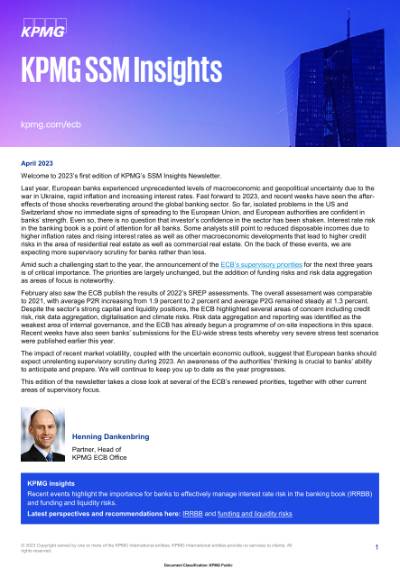April 2023
Lombard loans, also known as margin loans, have been a banking product for centuries. They take their name from the Lombards of Northern Italy, who first established the conventions of banking in the Middle Ages. Until recently, Lombard loans have rarely been the focus of supervisory attention, but that is changing — as we now explain.
In simple terms, Lombard loans are a specialised form of personal lending in which banks grant secured credit to their private wealth management clients. The key feature of these loans is that they are significantly over-collateralized with liquid assets — typically, readily marketable financial securities.
This long-established, niche form of personal lending and specific credit risk has not been the focus of supervisory attention in recent years. But that is changing. In fact, Lombard loans are emerging as an unlikely source of ongoing discussion between banks and supervisors. Only a handful of banks have been directly affected so far, but more European lenders could soon be impacted.
At the heart of the issue is a contrasting view of how the credit risks of Lombard loans should be managed.
From the banks’ standpoint, Lombard loans generate a relatively low risk stream of additional income, while strengthening ties with important high-net-worth (HNW) customers. Standard credit risk management practice is to:
- Lend only to very or ultra HNW individuals;
- Focus on the value of the collateral and ensure it exceeds the value of the loan; and
- Conduct frequent collateral revaluations, with margin calls if required.
These unusual characteristics mean that banks generally do not tend to conduct in-depth assessments of individual clients’ creditworthiness. Besides, in order to maintain their ongoing business relationships, banks are hesitant to drive their HNW clients — who tend to be sensitive about their personal data — into the arms of their competitors, potentially into even a different jurisdiction, by asking for excessive amounts of financial information, such as income, assets, liabilities and tax arrangements.
From a regulatory point of view, however, Lombard loans are subject to the same credit risk management requirements as a conventional consumer loan. More specifically:
- According to the European Banking Authority’s (EBA) Guidelines on Loan Origination and Monitoring, a focus on creditworthiness — and not collateral — is mandatory. Typically, that means using standardised data and processes to calculate individual borrowers’ debt service capacity.
- The IFRS 9 requirement for a significant increase in credit risk demands lenders to assess credit risks at each reporting date, based on any change in the probability of default (PD) over the life of the loan without considering the expected loss and therefore, implicitly, the collateral.
In short, standard banking practice and the requirements of regulation currently take different views on the role of collateral in the risk management of Lombard loans.
In essence, banks are concerned that strict enforcement of the rules could put the whole business model at risk, with HNW customers either declining to share their personal financial data and taking their business to banks in other jurisdictions that have a more favourable regulatory environment for these specific products. Some banks have argued that the principle of risk proportionality provides a justification for focusing on collateral value rather than calculations of debt service ability.
For now, however, supervisors remain aligned to the EBA’s Guidelines. Following recent on-site inspections (OSIs), at least two banks have recently received a finding from their supervisory authority for their approach to credit risk in this area. European authorities’ focus on Lombard loans seems likely to increase.
So how should banks respond to this potential source of disagreement? We recommend a few key steps:
- Be prepared. Expect supervisors to ask about Lombard loans. Understand the nature of their concerns and assess the gap between current practice and regulation. Anticipate the questions or objections that joint supervisory teams (JSTs) might raise.
- Make some changes. Take reasonable steps to comply with the principles of the guidelines, without changing the whole business model. Build a case — based on historical data — that justifies current approaches to the credit risk management of Lombard loans.
- Prepare the data. Be ready to answer questions from JSTs. If, for example, a bank conducts limited creditworthiness analysis, it should expect to be asked about the chosen data, how it was obtained, why it is credible and relevant, how it affects credit risk assessments, and how the data was verified through external sources.
It looks increasingly likely that supervisors will be asking more questions about the credit risk management of Lombard loans in the future. Until an understanding of the role of collateral can be reached, banks should prepare themselves for greater scrutiny of this small but important activity.
Connect with us
- Find office locations kpmg.findOfficeLocations
- kpmg.emailUs
- Social media @ KPMG kpmg.socialMedia




